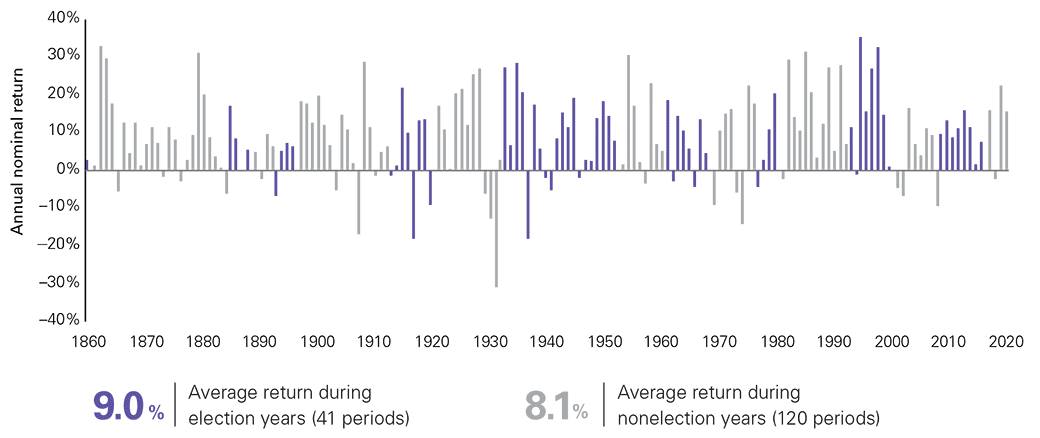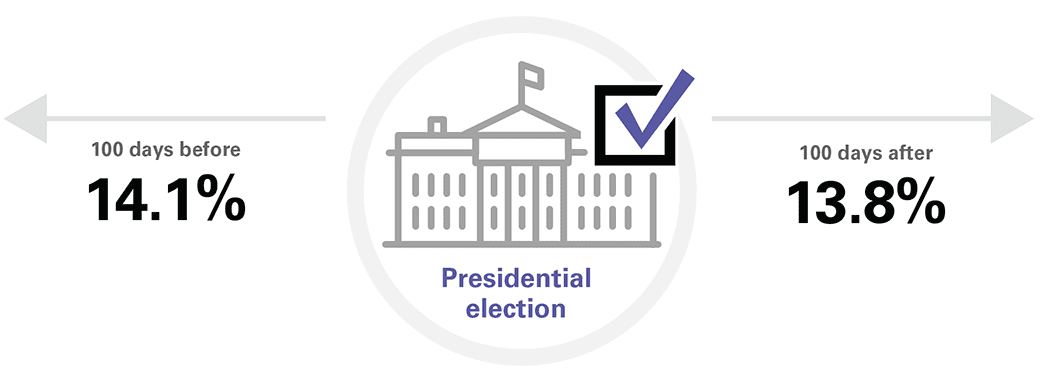Election years can be fraught with uncertainty as developments surrounding the candidates, their platforms, and their predicted effects on the economy and markets dominate the news. But should you let this stream of political information influence how you and I manage your investment portfolio?
A lengthy history of empirical research suggests not.
Elections matter, just not in all the ways you might think to an investor. Of course, they hold great importance in upholding the U.S. tradition of democratic, representative government. However, their impact on market returns has historically proved to be negligible, as shown in the chart below.
Comparing election years versus nonelection years: 60% stock/40% bond portfolio returns show no significant statistical difference

Source: Vanguard calculations, based on data from Global Financial Data, as of December 31, 2020. Data represents the 60% GFD US-100 Index and 40% GFD US Bond Index, as calculated by historical data provider Global Financial Data. The GFD US-100 Index includes the top 25 companies from 1825 to 1850, the top 50 companies from 1850 to 1900, and the top 100 companies by capitalization from 1900 to the present. In January of each year, the largest companies in the United States are ranked by capitalization, and the largest companies are chosen to be part of the index for that year. The next year, a new list is created and it is chain-linked to the previous year’s index. The index is capitalization-weighted, and both price and return indexes are calculated. The GFD US Bond Index uses the U.S. government bond closest to a 10-year maturity without exceeding 10 years from 1786 until 1941 and the Federal Reserve’s 10-year constant maturity yield beginning in 1941. Each month, changes in the price of the underlying bond are calculated to determine any capital gain or loss. The index assumes a laddered portfolio that pays interest on a monthly basis. All returns assume dividends/interest coupons are reinvested into their respective indexes. Average returns are a geometric mean.
Note: Past performance is no guarantee of future returns. The performance of an index is not an exact representation of any particular investment, as you cannot invest directly in an index.
Given the horse-race nature of political campaigns, you may think that in the months closest to an election, there is a noticeable uptick in volatility. Think again. In actuality, the opposite has been true. From January 1, 1964, to March 21, 2021, the Standard & Poor’s 500 Index’s annualized volatility was 14.1% in the 100 days before a presidential election and 13.8% in the 100 days after a presidential election, both of which were lower than the 16.2% annualized volatility for the full time period.
Volatility and the vote: Markets tend to ignore elections
S&P 500 Index annualized volatility
Full time period: 16.2%

Source: Vanguard calculations of S&P 500 Index daily return volatility from January 1, 1964, through March 21, 2021, based on data from Thomson Reuters.
Note: Past performance is no guarantee of future returns. The performance of an index is not an exact representation of any particular investment, as you cannot invest directly in an index.
The bottom line: Elections are another one of those events that generate lots of headlines but that should not sway you from following the financial plan we created. It’s understandable to have concerns about the election. But as far as your portfolio and the markets are concerned, history suggests it will be a nonissue.
Part of successful investing is understanding what you can control, and letting your emotions take a back seat to the financial plan we put in place. By maintaining perspective, discipline, and a long-term outlook, you can sustain progress toward your financial goals, despite the short-run uncertainty that events such as elections can create.





